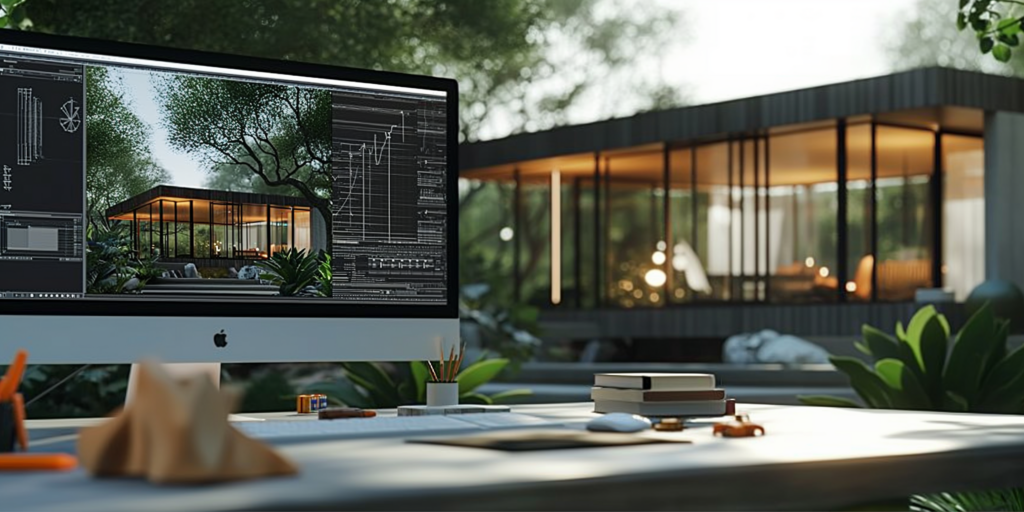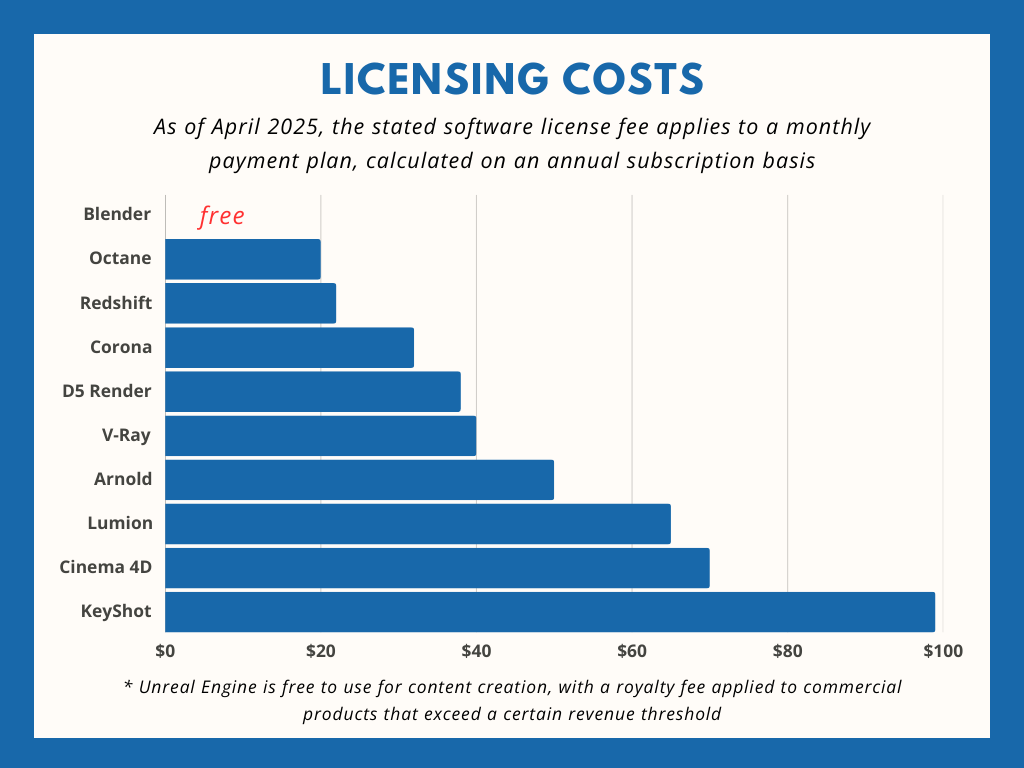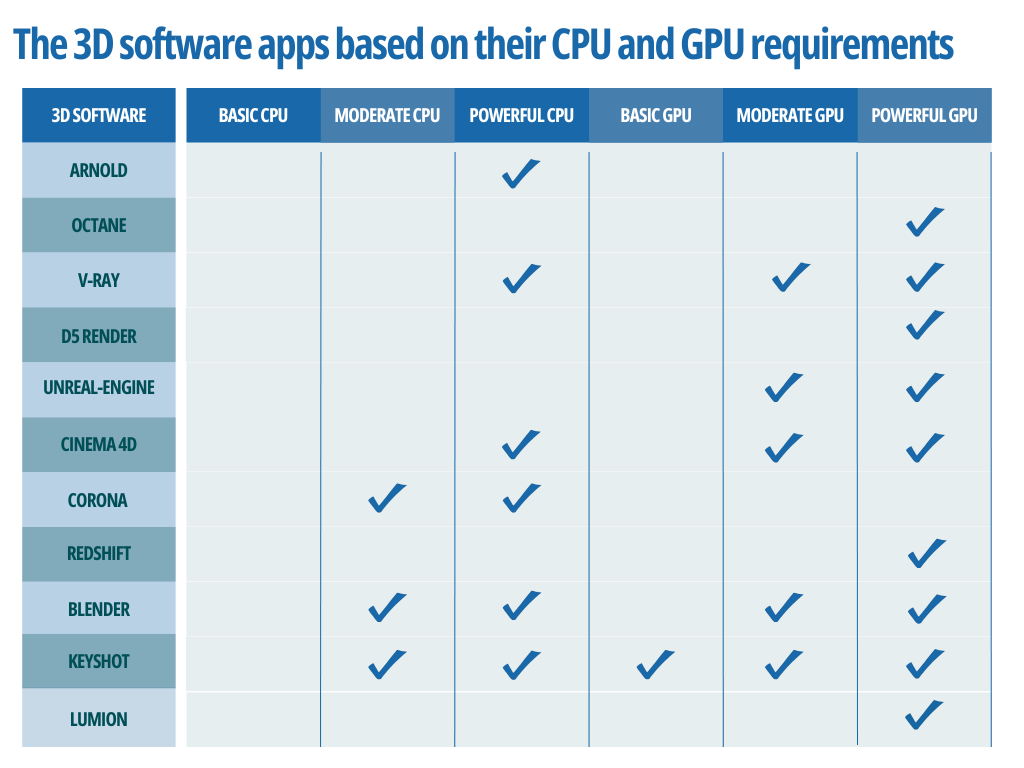
3D rendering software plays a key role in architectural visualization, product design, and animated films, allowing you to create stunning visuals of 3D models. As technology advances, 3D rendering tools have become more user-friendly and efficient, making it possible to produce photorealistic images and immersive experiences like never before. In this post, I’ll explore the best 3D rendering software in 2025, covering top rendering engines that help create photorealistic images for animation, product visualization, and architectural rendering.
How to Choose the Best 3D Rendering Software for Your Projects
First, when selecting a 3D rendering tool, please consider the following key factors and ensure it meets your specific rendering needs. Here’s what I learned from my journey:
- Ease of use: Starting with beginner-friendly software like SketchUp and then moving to advanced tools such as Autodesk 3ds Max taught me how crucial an intuitive interface and a short learning curve are. They enable you to accomplish more in less time without overwhelming you.
- Available features: At the beginning, determine the most relevant features to your projects. For example, if you need to manage complex scenes or create high-quality renders, software like Octane Render provides advanced features for these tasks.
- Licensing and costs: Your options range from free tools like Blender to subscription-based solutions like Redshift. Carefully evaluate your licensing needs and budget to choose the best 3D software that aligns with your financial and creative goals.
- Practical considerations: Look for features that enhance efficiency, such as network and GPU rendering, which can significantly reduce render times. Cloud rendering services can benefit large-scale projects by granting access to powerful cloud servers. Cloud infrastructure allows you to meet tight deadlines and streamline workflows without expensive hardware upgrades.
By carefully evaluating all these factors, you’ll be better prepared to choose the best 3D modeling software that aligns with your creative vision, budget, and technical requirements.
Best 3D Rendering Software in 2025: Features, Use Cases, Pros, and Cons
The demand for high-quality renders continues to rise across various industries, and the ability to visualize and animate models has become more crucial than ever. Whether working on interior environments, producing animations, or creating immersive experiences, choosing the best software is essential to achieve professional-grade results.
I’ll break down each tool’s features, advantages, and potential drawbacks to help you find the best 3D rendering software for your specific creative projects and rendering workflow.
| 3D Software | Rendering engine type | Key features and strengths | Popular use cases | PROS | CONS |
|---|---|---|---|---|---|
| Arnold | CPU | physically-based rendering, handles complex scenes efficiently | film, TV, visual effects, high-end 3D production | photorealistic results, deep integration with Maya and 3ds Max | steep learning curve, slower than GPU-based engines |
| Octane | GPU | GPU-accelerated ray-tracing, fast rendering speeds, realistic lighting | VFX, 3D art, graphic design, product visualization | fast GPU rendering, real-time preview | requires a high-end Nvidia GPU |
| V-Ray | CPU and GPU | photorealistic renders, comprehensive material library | architectural visualization, interior design, VFX | high-quality photorealistic renders | overwhelming for beginners |
| D5 Render | RTX GPU | real-time path tracing, AI-powered enhancement, live sync with SketchUp/Revit | Architectural visualization, interior rendering | intuitive UI, AI tools, strong SketchUp/Revit integration, built-in asset library | Windows-only, requires RTX GPU |
| Unreal Engine | Real-time | real-time ray tracing, vast asset library | game development, architectural visualization, virtual production | real-time feedback, high-visual fidelity | steeper learning curve, requires optimization for best results |
| Cinema 4D | CPU and GPU | user-friendly interface, powerful MoGraph tools, Redshift integration | motion graphics, 3D animation, design | easy of use, efficient workflow | higher cost compared to alternatives |
| Corona | CPU | easy to use, realistic lighting, advanced material library | architectural visualization, interior and product rendering | user-friendly interface, simple setup | slower CPU-based rendering |
| Redshift | GPU | fast GPU-based rendering, efficiency in complex scenes | animation, VFX, architecture | high-performance, handles heavy scenes well | requires high-end Nvidia GPU |
| Blender | CPU and GPU | free and open-source, powerful modeling and animation tools, comprehensive feature set | animation, modeling, game assets, general 3D work | free licensing, highly versatile | Steep learning curve for beginners |
| KeyShot | CPU and GPU | real-time rendering, advanced lighting, and material library | product and industrial design, concept art | real-time feedback, photorealistic results, minimal setup | performance depends on hardware |
| Lumion | Real-time | quick rendering, intuitive interface, large asset library | architectural visualization, landscape design | extremely fast for architecture renders | expensive, requires powerful hardware |
Arnold Render – Top Choice for High-Quality Renders
Autodesk Arnold is one of the most powerful tools among the best 3D rendering software for high-end production workflows. It is widely used in film production and visual effects. Its ability to handle complex scenes and deliver photorealistic rendering has made it a go-to solution for many animators and VFX professionals.
Here’s what makes it stand out:
- High-Quality Rendering: Arnold produces stunning rendered images, particularly for projects involving detailed 3D models and realistic lighting. Its integration with Autodesk 3ds Max makes it an excellent choice for professionals familiar with Autodesk 3D modeling software.
- CPU Rendering Focus: Arnold relies on CPU rendering. It delivers precision but might be slower than GPU rendering, especially for time-sensitive projects.
- Advanced Features: Arnold’s extensive capabilities come with a steep learning curve, which may be challenging for those new to 3D design or visual effects.
- System Requirements: To run Arnold smoothly, you’ll need a multi-core processor, sufficient RAM, and a compatible graphics card.
- Licensing: Prices start at about $50 monthly for a single-user license, as volume discounts are available for teams.
Arnold is ideal for professionals seeking high-quality and precise rendering for demanding projects.
Octane Render – Pioneering GPU Rendering
Octane Render by OTOY is cutting-edge GPU rendering software that uses the processing power of graphics cards to deliver exceptional rendering speed. Octane is particularly popular among 3D artists, designers, and motion graphics professionals.
- GPU-Powered Efficiency: Octane relies on GPUs that enable a significantly faster rendering workflow, making it ideal for creating realistic images and complex 3D animation.
- User-Friendly Interface: Its intuitive design simplifies the rendering process even for beginners in 3D rendering tools.
- Hardware Requirements: Octane performs best with an NVIDIA graphics card that supports CUDA. I recommend high-end GPU servers, which may be challenging for basic hardware setups.
- Flexible Subscription Model: Octane Render offers flexible and affordable plans, starting at $20 monthly for the Studio version. Enterprise plans provide advanced features and network rendering.
Octane Render combines speed, usability, and scalability, making it an excellent choice for professionals seeking photorealistic rendering and streamlined workflows.
V-Ray Render – The Versatile Rendering Plugin
V-Ray is a highly versatile rendering plugin that integrates easily with popular 3D modeling software like SketchUp and 3ds Max. Its ability to produce photorealistic images at a remarkable speed makes it a preferred choice for architectural, interior, and product design.
- High-Quality Results: V-Ray advanced features for lighting, texture mapping, and camera settings allow you to create stunning 3D visualizations and interior renderings.
- Broad Compatibility: The plugin works with multiple platforms, making it a versatile option for 3D workflows in various industries.
- Challenging for Beginners: V-Ray offers a wide range of capabilities but comes with a steeper learning curve, which can be challenging for beginners.
- GPU Rendering Support: V-Ray supports GPU rendering, which enhances its speed and efficiency when paired with compatible hardware. It also offers network rendering, making it suitable for large-scale projects.
- Licensing: Its cost, starting at $40 monthly for a fixed license on a single workstation, might be a barrier for small studios or freelancers.
V-Ray combines versatility, precision, and scalability, making it an excellent choice for professionals seeking realistic rendering in their 3D projects.
D5 Render – Create in Real Time with Built-in AI
D5 Render is a real-time rendering software designed for architects and designers who need fast, photorealistic visuals without a steep learning curve. It combines real-time path tracing, live-sync with tools like SketchUp and Revit, and a built-in asset library to streamline the entire visualization workflow. Lightweight yet powerful, D5 stands out as one of the most intuitive and efficient rendering solutions available today.
- Real-Time Lighting and Materials: D5’s real-time path tracing and robust PBR material system allow users to achieve cinematic lighting and lifelike textures with minimal setup – ideal for architectural and interior projects.
- High-Speed, High-Quality Output: GPU acceleration enables the creation of stunning stills and animations in minutes, even for complex scenes.
- Performance Optimized: Remains lightweight and responsive when handling large-scale architectural models, ensuring a smooth workflow.
- AI-Powered Enhancements: As the first renderer to integrate AI tools, D5 helps automate lighting, animation, and material refinements for faster, more consistent results.
- System Requirements: Requires a Windows system with an NVIDIA RTX GPU, at least 16GB RAM, and SSD storage for optimal performance.
- Pricing: A free version is available with core features; Pro plans start at $38/month, with flexible options for teams.
D5 Render offers an intuitive, high-performance solution that empowers architects and designers to produce stunning visuals in real time – combining speed, quality, and ease of use in one powerful platform.
Unreal Engine Render – Real-Time Immersive Experience
Developed by Epic Games, Unreal Engine is more than a 3D rendering tool. It’s a powerful game engine providing real-time rendering and architectural visualization, making it a top choice for 3D artists, architects, and virtual reality designers.
- Real-Time Rendering: Unreal Engine provides instant visual feedback during the rendering workflow, which is invaluable for creating interactive 3D models and immersive virtual reality experiences.
- Extensive Resources: The platform features a vast library of resources, tutorials, and a thriving community to help new users overcome its complexity.
- System Requirements: To run Unreal Engine, you need a powerful CPU, a DirectX 11 or 12-compatible GPU, and at least 8 GB of RAM (recommend more for complex projects).
- Flexible Pricing: Unreal Engine is free for content creation, but commercial products generating significant revenue are subject to a royalty fee. This model is especially appealing to independent creators and growing studios.
Despite its complexity, Unreal Engine stands out for its real-time rendering capabilities, making it a leader in architectural rendering software, 3D visualization, and creating photorealistic images for motion graphics and virtual reality workflows.
Cinema 4D Render – Intuitive Interface for Creatives
Maxon Cinema 4D is well-known for its user-friendly interface and extensive features. Its ability to produce easily high-quality 3D content makes it popular in motion graphics, 3D animation, and architectural rendering.
- Accessible for All Skill Levels: Cinema 4D’s straightforward workflow and user-friendly design make it an excellent choice for beginners, while its advanced tools perfectly fit the needs of experienced 3D artists and architects.
- Versatile Features: Whether you’re creating 3D models, producing photorealistic renderings for architectural visualization, or crafting motion graphics, Cinema 4D’s extensive feature set adapts to a wide range of projects.
- Hardware Requirements: For optimal performance, recommend a 64-bit processor, at least 8 GB of RAM, and an OpenGL-compatible graphics card.
- Pricing Considerations: The monthly fee starts at $70, which might seem high for some users. However, its integration with network rendering and dedicated Cinema 4D render farm service makes it an excellent choice for collaborative and large-scale projects.
Cinema 4D combines simplicity with functionality, appealing to beginners and professionals who aim to create stunning 3D visuals.
Corona Render – Simplifying Photorealistic Rendering
Corona Render is an excellent choice for producing photorealistic images effortlessly, without sacrificing quality. One of its standout features is the intuitive interface, which offers a gentle learning curve for beginners.
- Lighting and Material Excellence: Corona’s robust handling of lighting effects and its extensive material library streamline the 3D rendering process, making it ideal for interior design and architectural visualization.
- Realistic Results: Create highly realistic images intended for professional-quality architectural rendering.
- CPU Rendering Focus: Corona Render relies on CPU rendering, which can be slower than GPU rendering for complex scenes or time-sensitive tasks.
- Considerations for Large Projects: While not a deal-breaker for many, CPU rendering may require additional time for highly complex scenes or projects with tight deadlines.
- System Requirements: Runs on Windows and requires a multi-core processor, ample RAM, and compatible graphics hardware for smooth operation.
- Pricing: Subscriptions start at $32 monthly for a single render node license, with volume discounts available for studios.
Corona Render offers a reliable, user-friendly solution that excels in high-quality visualizations and ease of use for architects and interior designers.
Redshift Render – High-Performance Rendering for Complex Scenes
For fast and efficient 3D rendering, Redshift is one of the best GPU-accelerated options in the 3D rendering software market. When speed is your priority, Redshift consistently delivers exceptional results, making it ideal for animation, VFX, and large-scale 3D projects. Redshift, as a GPU-accelerated rendering engine, efficiently handles complex 3D scenes, significantly reducing render times compared to CPU-based engines.
Its ability to integrate seamlessly with leading 3D modeling software, such as 3ds Max, Cinema 4D, and Maya, has made it invaluable for artists and studios requiring high-performance rendering. Whether working on real-time visual effects or photorealistic renders, Redshift’s speed and efficiency make it an essential tool for professionals.
- System Requirements: Optimized for NVIDIA GPUs with CUDA support. A powerful graphics card is essential for unlocking its full potential.
- Pricing: Starts at $22 monthly for standard licenses, with floating license options for studios managing multiple users.
Redshift has been indispensable in projects requiring photorealistic rendering at scale. Its network rendering capabilities have saved countless hours, particularly during large-scale animations, allowing teams to meet tight deadlines without sacrificing quality.
Blender Render – The Open-Source Game-Changer
Blender is one of the best 3D rendering software options for those new to 3D modeling or professionals seeking a powerful, cost-effective solution. As a free, open-source platform, Blender 3D rendering software delivers a comprehensive suite of features for 3D animation, architectural visualization, and high-quality rendering workflows. Whether you’re working on Blender for 3D modeling, 3D rendering, or animation, its robust toolset makes it a versatile choice for artists and designers.
- Feature-Rich and Versatile: Blender supports both CPU and GPU rendering, making it adaptable for a wide range of workflows, whether you create realistic images, explore virtual reality, or work on complex animations.
- Learning Curve: Initially, I found the Blender interface a bit overwhelming. However, its active community and extensive tutorials make mastering its versatility much easier.
- System Requirements: Blender requires a minimum of 4 GB of RAM to run, but I highly recommend having 16 GB or more for optimal performance when having complex scenes.
- Cost: Completely free, making it accessible for new and professional 3D artists.
Blender has been my go-to for fast rendering and producing high-quality visuals. Its open-source nature also makes it ideal for collaborating with cloud render farms, offering flexibility and efficiency for large-scale rendering projects. For Blender users, services like the MaxCloudON Blender Render Farm and their automated RenderSonic solution provide dedicated resources and streamline your workflow to accelerate rendering time and manage complex scenes effortlessly.
KeyShot, developed by Luxion, is renowned for its real-time rendering and user-friendly interface, making it an excellent choice for product design and visualization. This rendering software emphasizes simplicity without compromising on high-quality results, making it ideal for professionals and beginners.
- Real-Time Rendering: KeyShot provides instant feedback during the rendering process, allowing you to experiment with materials, lighting, and environments effortlessly.
- Photorealistic Visuals: Its advanced features, such as global illumination and HDRI lighting, deliver stunning, lifelike images tailored for product design and marketing visuals.
- Ease of Use: The intuitive interface and drag-and-drop functionality ensure a seamless workflow, even for those new to 3D rendering tools.
- System Requirements: KeyShot supports both CPU and GPU rendering, allowing you to select the mode that best fits your hardware and project requirements. It requires a 64-bit processor and a minimum of 8 GB of RAM, though higher specifications are recommended for handling complex scenes effectively.
- Licensing Options: Pricing starts at $99 monthly for the subscription model, with lifetime licenses available for long-term use.
KeyShot’s ability to create detailed and realistic product renderings makes it an indispensable tool for designers looking to showcase their 3D models with precision and style.
Lumion Render – Speed up Your Architectural Visions
Lumion is the best 3D rendering software for architects and 3D artists, providing fast, high-quality results without a steep learning curve. Its intuitive interface and extensive library of materials and objects simplify the rendering process, making it ideal for beginners and professionals.
- Fast and Efficient: Lumion excels at managing large scenes and delivering photorealistic images quickly, making it a preferred choice for architectural rendering and design visualization.
- User-Friendly Interface: The simplified design provides an accessible experience, even for users with little experience in 3D modeling software.
- System Requirements: A powerful CPU, fast GPU, and substantial system memory are essential for optimal performance, especially when handling complex 3D models.
- Pricing: Begins at $65 monthly for the standard version, with volume discounts available for larger teams.
Lumion’s speed and ability to produce realistic images make it a valuable tool for large-scale projects and architectural visualization workflows.
Each software has unique advantages, such as Corona Render’s user-friendly interface, Redshift speed, and Blender versatility. Your choice should align with your specific needs, whether your goal is photorealistic rendering, real-time visualization, or motion graphics. Next, I will compare these tools to enhance your workflow.


Comparative Analysis of 3D Rendering Software
Choosing the best 3D rendering software depends on your specific requirements, skill level, and the type of projects you work on. Based on my experience, here’s a comparative analysis of the leading rendering tools regarding ease of installation, user-friendliness, cost-effectiveness for cloud rendering, and popularity among 3D artists. MaxCloudON transparent cloud GPU render farm prices can help you plan your budget effectively.
Ease of Installation
For those seeking a quick setup, Blender excels. Its straightforward installation and extensive community make it accessible and running within minutes. As an open-source platform, it’s accessible to beginners and professionals, allowing for a seamless introduction to 3D rendering and modeling. When I first started with 3D modeling, Blender’s hassle-free setup gave me the confidence to explore its vast capabilities.
Cinema 4D also shines in ease of installation, with its intuitive design and logical workflow making it a favorite among creatives. Whether you’re a beginner or an experienced artist, the quick setup process and user-friendly interface ensure you can start producing high-quality renders in no time. Blender and Cinema 4D are excellent options for those looking for a smooth and efficient installation experience.
User-Friendliness
When it comes to intuitive design, Cinema 4D takes the lead. Its user-friendly interface and logical workflow have been instrumental in motion graphics and 3D animation projects. The interface is designed with creatives in mind, making it easier to focus on your vision rather than the technical aspects.
D5 Render offers a clean, intuitive interface built for architects. With real-time feedback, drag-and-drop materials, and live sync with tools like SketchUp and Revit, it makes rendering fast and frustration-free.
Similarly, Lumion offers a simplified workflow for interior rendering and architectural visualization. Its vast library of pre-made objects and materials allows you to produce professional-quality renders without extensive training. This software has been a lifesaver for quick 3D renders when time was of the essence.
Cost-Effectiveness for 3D Rendering Service
Blender is unmatched in cost-effectiveness if you consider using a cloud rendering service. As a free, open-source platform, it allows seamless integration with cloud render farms without additional licensing costs. I’ve used Blender extensively for collaborative projects on platforms like MaxCloudON, and it continues to be my top choice for budget-conscious workflows.
D5 Render strikes a great balance between price and power – free to start, with Pro plans from $38/month. Built-in cloud tools and smooth performance make it ideal for fast-moving architectural teams.
Corona Render and Redshift are also worth mentioning here. Both offer competitive pricing models, and their volume discounts make them ideal for scaling operations on cloud platforms. With Infrastructure as a Service, studios can easily access scalable resources, streamlining larger 3D visualization projects. These tools have proven invaluable for delivering photorealistic images efficiently and cost-effectively.
Popular Among 3D Professionals
Among interior designers and 3D artists, V-Ray holds a special place. Its ability to produce realistic images and adapt to various workflows has made it a favorite for architectural rendering software. I’ve often used V-Ray for product design and 3D content, and its versatility never disappoints.
D5 Render is gaining traction fast with architects and 3D studios for its real-time quality, sleek visuals, and seamless workflow. Top firms now use it to deliver polished, collaborative presentations – faster than ever.
On the other hand, Blender’s growing popularity is fueled by its accessibility and the dedication of its community. The constant development of plugins and tutorials ensures that it remains a top contender for both beginners and experienced professionals in the 3D rendering space.
Key Takeaways
The choice of rendering software ultimately comes down to your specific needs and the projects you tackle. Here’s a quick summary of what stands out:
- Best for Beginners: Cinema 4D and Lumion offer intuitive interfaces for those just starting their journey in 3D design.
- Best for Cost-Effectiveness: Blender is unbeatable for free and open-source options, especially for cloud rendering workflows.
- Best for Speed: Redshift and Octane Render excel in GPU rendering, making them ideal for time-sensitive projects.
- Best for Architectural Visualization: V-Ray, Lumion, Corona Render, and D5 Render provide the essential tools for creating photorealistic renderings in architectural projects.
Conclusion
Choosing the right 3D rendering software is crucial for achieving high-quality visuals, whether you’re working on animations, product visualization, or architectural projects. The best 3D rendering software balances ease of use, rendering speed, and advanced features to meet professional demands, ensuring efficient workflows and stunning results.
For those focusing on photorealistic rendering at scale, Redshift has been indispensable, offering network rendering capabilities that save countless hours – especially in large-scale animations and VFX projects. If you’re looking for free and open-source 3D rendering software, Blender provides a powerful and versatile toolset for animation, modeling, and visualization, making it ideal for both beginners and professionals.
On the other hand, tools like V-Ray, Corona Render, Lumion, and D5 Render cater to architectural visualization, while Cinema 4D excels in motion graphics. Regardless of your industry – film, gaming, architecture, or product design – the best 3D rendering software should align with your creative vision, rendering speed needs, and workflow efficiency.
By leveraging high-performance cloud solutions, such as MaxCloudON’s cloud rendering services, you can further optimize your rendering workflow, reduce hardware limitations, and scale your projects effortlessly. Whether you’re an independent artist, a studio, or a business, choosing the right software and rendering infrastructure will help you achieve stunning visuals with maximum efficiency.
Sources:
- Autodesk Arnold
- OTOY Octane Render
- Chaos Group V-Ray
- D5 Render
- Epic Games Unreal Engine
- Maxon Cinema 4D
- Corona Renderer
- Redshift
- Blender
- KeyShot
- Lumion
Frequently Asked Questions:
-
What is the best 3D rendering software for beginners?
Blender and Cinema 4D are excellent for beginners due to their intuitive interfaces and extensive tutorials. Blender is free, while Cinema 4D offers professional features with a manageable learning curve.
-
Which 3D rendering software offers the best value for money?
Speaking about price and license costs – Blender is unbeatable as a free, open-source platform. For paid options, V-Ray and Redshift offer competitive pricing with advanced features, making them ideal for professional use.
-
What is the most cost-effective 3D rendering software for interior design?
Corona Render is a top choice for interior design, offering user-friendly features, photorealistic quality, and affordable subscription pricing starting at $32 per month. Another excellent option is Lumion, known for its intuitive interface and extensive library of materials and objects, making it ideal for creating quick and stunning interior visualizations.
-
What is the best software for photorealistic rendering?
V-Ray, Arnold, and Corona Render excel in producing photorealistic images, making them the top 3D rendering software for high-quality visualizations.
-
Which 3D rendering software is best for product design?
KeyShot and V-Ray are ideal for product design, offering advanced materials, realistic lighting, and detailed rendering tools tailored for product visualization.
-
Can I use cloud rendering services with all 3D rendering software?
Yes, you can use cloud rendering services with all 3D rendering software. MaxCloudON allows you to install and configure your preferred 3D rendering software, along with any required plugins and scripts, ensuring compatibility with your unique workflows.











